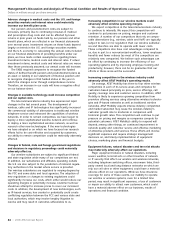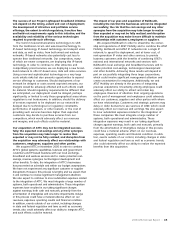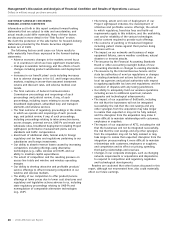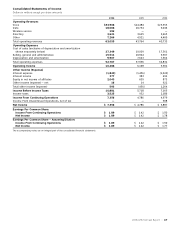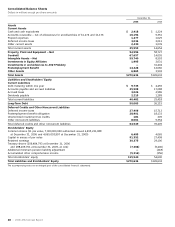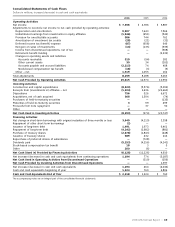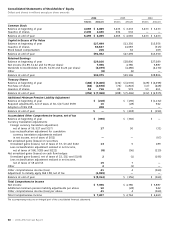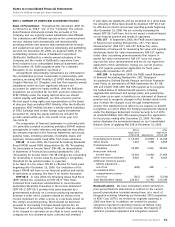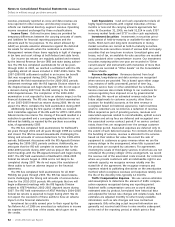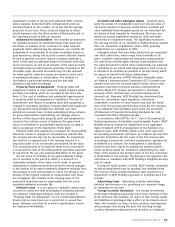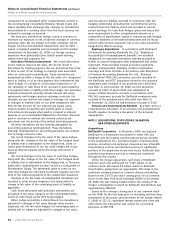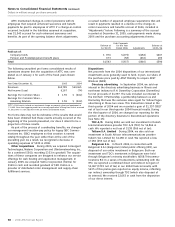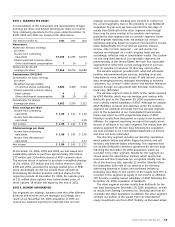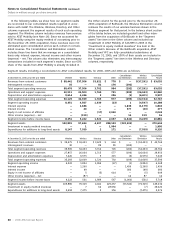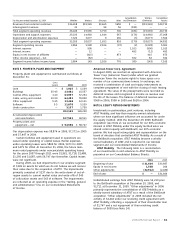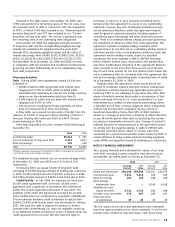AT&T Wireless 2006 Annual Report Download - page 55
Download and view the complete annual report
Please find page 55 of the 2006 AT&T Wireless annual report below. You can navigate through the pages in the report by either clicking on the pages listed below, or by using the keyword search tool below to find specific information within the annual report.
2006 AT&T Annual Report : :
53
adjustment is made to the accrued switched traffic compen-
sation expense. Dedicated traffic compensation costs are
estimated based on the number of circuits and the average
projected circuit costs. These costs are adjusted to reflect
actual expenses over the three months following the end of
the reporting period as bills are received.
Allowance for Uncollectibles We maintain an allowance
for doubtful accounts for estimated losses that result from
the failure or inability of our customers to make required
payments. When determining the allowance, we consider the
probability of recoverability of accounts receivable based on
past experience, taking into account current collection trends
as well as general economic factors, including bankruptcy
rates. Credit risks are assessed based on historical write-offs,
net of recoveries, as well as an analysis of the aged accounts
receivable balances with reserves generally increasing as the
receivable ages. Accounts receivable may be fully reserved
for when specific collection issues are known to exist, such
as pending bankruptcy or catastrophes. The analysis of
receivables is performed monthly and the bad debt
allowances adjusted accordingly.
Property, Plant and Equipment Property, plant and
equipment is stated at cost, except for assets acquired using
purchase accounting, which are recorded at fair value (see
Note 2). The cost of additions and substantial improvements
to property, plant and equipment is capitalized. The cost of
maintenance and repairs of property, plant and equipment is
charged to operating expenses. Property, plant and equipment
are depreciated using straight-line methods over their
estimated economic lives. Certain subsidiaries follow compos-
ite group depreciation methodology; accordingly, when a
portion of their depreciable property, plant and equipment is
retired in the ordinary course of business, the gross book
value is reclassified to accumulated depreciation; no gain or
loss is recognized on the disposition of this plant.
Property, plant and equipment is reviewed for recoverability
whenever events or changes in circumstances indicate that
the carrying amount may not be recoverable. An impairment
loss shall be recognized only if the carrying amount of a
long-lived asset is not recoverable and exceeds its fair value.
The carrying amount of a long-lived asset is not recoverable
if it exceeds the sum of the undiscounted cash flows expected
to result from the use and eventual disposition of the asset.
The fair value of a liability for an asset retirement obliga-
tion is recorded in the period in which it is incurred if a
reasonable estimate of fair value can be made. In periods
subsequent to initial measurement, period-to-period changes
in the liability for an asset retirement obligation resulting from
the passage of time and revisions to either the timing or the
amount of the original estimate of undiscounted cash flows
are recognized. The increase in the carrying value of the
associated long-lived asset is depreciated over the corre-
sponding estimated economic life.
Software Costs It is our policy to capitalize certain costs
incurred in connection with developing or obtaining internal-
use software. Capitalized software costs are included in
“Property, Plant and Equipment” on our Consolidated Balance
Sheets and are amortized over a period not to exceed five
years. Software costs that do not meet capitalization criteria
are expensed immediately.
Goodwill and Other Intangible Assets Goodwill repre-
sents the excess of consideration paid over the fair value of
net assets acquired in business combinations. Goodwill and
other indefinite-lived intangible assets are not amortized but
are tested at least annually for impairment. We have com-
pleted our annual impairment testing for 2006 and deter-
mined that no impairment exists. The significant increase in
the carrying amount of our goodwill in 2006 primarily resulted
from our acquisition of BellSouth, and in 2005, primarily
resulted from our acquisition of ATTC.
Intangible assets that have finite useful lives are amortized
over their useful lives, which range from 6 months to 18
years. Customer relationships are amortized using primarily
the sum-of-the-months-digits method of amortization over
the expected period in which those relationships are expected
to contribute to our future cash flows based in such a way as
to allocate it as equitably as possible to periods during which
we expect to benefit from those relationships.
A significant portion of AT&T Mobility’s intangible assets
are Federal Communications Commission (FCC) licenses that
provide them with the exclusive right to utilize certain radio
frequency spectrum to provide wireless communications
services. While FCC licenses are issued for a fixed time,
renewals of FCC licenses have occurred routinely and at
nominal cost. Moreover, AT&T Mobility has determined that
there are currently no legal, regulatory, contractual,
competitive, economic or other factors that limit the useful
lives of its FCC licenses and therefore treats the FCC licenses
as an indefinite-lived intangible asset under the provisions
of Statement of Financial Accounting Standards No. 142,
“Goodwill and Other Intangible Assets.”
In accordance with EITF No. 02-7, “Unit of Accounting for
Testing Impairment of Indefinite-Lived Intangible Assets,” AT&T
Mobility tests its licenses for impairment on an aggregate
basis, consistent with its management of the business on a
national scope. AT&T Mobility utilizes a fair value approach,
incorporating discounted cash flows, to complete the test. This
approach determines the fair value of the FCC licenses and,
accordingly, incorporates cash flow assumptions regarding the
investment in a network, the development of distribution
channels and other inputs for making the business opera-
tional. As these inputs are included in determining free cash
flows of the business, the present value of the free cash flows
is attributable to the licenses. The discount rate applied to the
cash flows is consistent with AT&T Mobility’s weighted-average
cost of capital.
During the fourth quarter of 2006, AT&T Mobility completed
its annual impairment tests for goodwill and indefinite-lived
FCC licenses. These annual impairment tests resulted in no
impairment of AT&T Mobility’s goodwill or indefinite-lived FCC
licenses.
Advertising Costs Advertising costs for advertising
products and services or for promoting our corporate image
are expensed as incurred.
Foreign Currency Translation Our foreign investments
and foreign subsidiaries generally report their earnings in their
local currencies. We translate our share of their foreign assets
and liabilities at exchange rates in effect at the balance sheet
dates. We translate our share of their revenues and expenses
using average rates during the year. The resulting foreign
currency translation adjustments are recorded as a separate



